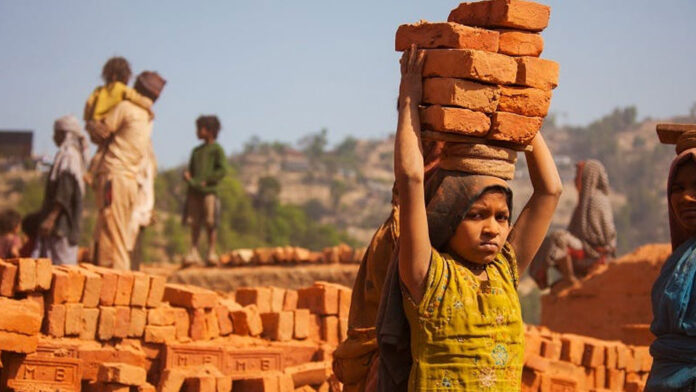Child labour is a global issue that is often overlooked by governments and accepted as a necessity. It has been shown to have negative impacts on physical and mental health, including poor growth, malnutrition, infections, chronic lung disease, and musculoskeletal deformities. Child labour is a prevalent problem that frequently arises from harsh circumstances.
Parental volatility and poverty lead to child labour, which is made worse by unreliable financial markets that distribute short-term gains and long-term costs among several parties. It is dangerous to romanticise the idea that children learn essential life skills from domestic work, as there is no evidence that these skills are associated with better outcomes in school performance, wellbeing, or development. Even seemingly benign tasks like cooking can expose girls to indoor pollution.
The worst forms of child labour are categorized in article 3 of ILO Convention No. 182, which includes all forms of slavery, forced or compulsory labour, prostitution, illicit activities, and work that harms children’s health, safety, or morals. Hazardous work refers to work that exposes children to physical, emotional, or sexual abuse, work underground, underwater, at dangerous heights, or in confined spaces with dangerous machinery, equipment, and tools, or involves manual handling or transport of heavy loads. It also includes work in an unhealthy environment, under particularly difficult conditions, and in designated hazardous industries or occupations. Unpaid household services, or household chores, refer to services children provide without pay for their own households, such as caring for family members, cleaning, cooking, washing, ironing clothes, and transporting family members to and from work and school.
Millions of children worldwide engage in labour, often exploitative and essential for survival. Labour is nuanced and subjective, and it is important to reflect on the wider realities of children’s lives, including elements of pleasure like friendship, solidarity, dancing, drinking, drug taking, flirting, and sexuality. Integrating labour into understanding juvenile delinquency leads to a more expansive and reflective comprehension of young people’s involvement in gangs and organized crime. Debate around child exploitation and abuse and experiences of gangs can raise awareness of children’s involvement in organized crime and develop understanding of this complex, sensitive issue.
According to ILO (2021) data, around half of the 160 million children worldwide between the ages of 5 and 14 are full-time employed that constitute 10 percent of child labour globally. UNICEF estimates 63 million girls and 97 million boys, making up nearly one in ten children. 79 million children, or half, work in hazardous labour that poses a threat to their moral development, health, and safety. Despite an increase of almost 8 million children working over four years, the percentage of children engaged in child labour remained constant. UNICEF estimates that one in five primary school-aged children are not enrolled in school.
Education is considered a route out of poverty and underdevelopment, and compulsory education has helped eradicate child labour in 19th-century Europe, the USA, and Japan. However, today’s competitive global labour market has accentuated the premium on education. Contextual constraints set limits to children’s aspirations and achievements, but they must be overcome. Poverty, tradition, and religion often serve as smokescreens for governments, international agencies, and elites hiding their inaction on child labour, education, and other forms of exclusion.
Pakistan has ratified the ILO Conventions and other international accords, but one of its key challenges is combating child and forced labour. The number of child labour in Pakistan as per ILO estimates is as high as 3.3 million with 13 percent male and 10 percent female. The foundation of Pakistan’s economy is the agriculture sector, which contributes 19.5 percent of the country’s GDP. 60 percent of Pakistan’s exports are made up of cotton, a vital commodity in the nation’s value chain and source of employment for both men and women. Pakistan is ranked fourth in the world for cotton production and ninth for agriculture output. In Pakistan, but forced work is still a major problem in the cotton industry, with the largest prevalence being in the agricultural sector (74 percent). Children are frequently allowed to work by their parents to support family small enterprises (69 percent) and augment household income (28 percent).
Reducing child labour can be achieved most effectively through encouraging school attendance. While attending school might provide more benefits, improving school quality also has the unintended consequence of affecting future results. A targeted stipend to families who are taking their children to school is the most promising strategy for reducing child labour.
The incidence of child work fell sharply in Punjab between 2009 and 2021, whereas it peaked in Sindh between 2012 and 2018. Between 2014 and 2021, the rate of child work among females increased, with a larger prevalence among girls in Punjab than among boys. Less than three percent of youngsters aged 10 to 14 in Islamabad Capital were engaged in economic activity, which was the lowest occurrence. The adverse climatic events that are occurring more frequently in Pakistan’s rural areas are also forcing vulnerable households into poverty and increasing their susceptibility to forced or child labour. To lessen these risks, work and livelihood programs must be a part of recovery and rehabilitation initiatives. Successful engagement in world markets can also reduce child labour.
It is encouraging that the provincial governments are now able to implement laws protecting labour rights, including those protecting adults and children from forced labour and child labour in the textile, apparel, and agricultural industries. There are various steps that can be taken to address child labour, such as expanding access to high-quality education, assisting with programmes that reduce poverty, launching awareness campaigns, bolstering and enforcing current laws, putting in place social programmes that support families, working internationally with organisations and non-governmental organisations, keeping an eye on workplaces to spot and report child labour, promoting corporate responsibility, and integrating local communities in the planning and execution of initiatives. To bring about lasting change, a thorough and well-coordinated effort including local communities, private companies, non-governmental organisations, and government agencies is required.
Reducing child labour can be achieved most effectively through encouraging school attendance. While attending school might provide more benefits, improving school quality also has the unintended consequence of affecting future results. A targeted stipend to families who are taking their children to school is the most promising strategy for reducing child labour. This solution employs a current grant to offset the present expense of removing a child from the workforce, therefore addressing the underlying reasons of child employment. Every child’s right fosters a bright future by enabling them to develop a distinctive, robust, and beautiful identity.























